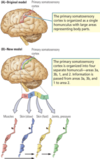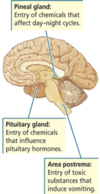Exam 1 Flashcards
(64 cards)
Why doesn’t complete destruction of the geniculostriate pathway in humans leave the person completely blind?
There is another optic pathway, the Tectopulvinar pathway.

antagonists
decrease neurotransmission effectiveness
V2 (thin, thick, pale strips)
- Thin: color
- Thick: form
- Pale: motion
N’C
F’ick
PaM

Name & describe 3 types agnosia
Agnosia: inability to combine individual visual impressions into complete patterns
- Visual form: inability to recognize line drawings of objects
- Prosopagnosia: facial-recognition deficit
-
Object agnosia:
- Apperceptive: Failure in object recognition but basic visual functions (acuity, color, motion) preserved
-
Associative: Inability to recognize an object despite its apparent perception
- can copy a drawing accurately but can’t ID it
- Results from lesions higher in the processing hierarchy, such as the anterior temporal lobe

blobs
color perception

Agonist
drugs that increase effectiveness of neurotransmissions

area postrema
medullary structure in the brain that controls vomiting
Astereognosis
Astereognosis (or tactile agnosia if only one hand is affected) is the inability to identify an object by active touch of the hands without other sensory input, such as visual or sensory information.
Draw and briefly describe Von Economo’s cytoarchitectonic regions of the parietal lobes and their associated functions.
- PE: Somatosensory
- PF: receives heavy input from the primary somatosensory cortex (through PE) and a small visual input through area PG.
- PG: “parieto-temporo-occipital crossroads;” controls spatially guided behavior with respect to visual and tactile information.

Apraxia
inability to perform particular purposive actions, as a result of brain damage.
simultanagnosia
inability to perceive the visual field as a whole
Simultaneous Extinction
- Somatoperceptual disorder in which two stimuli would be reported if applied singly, but only one would be reported if both were applied together
- Associated with damage to areas of PE and PF

Describe the structural and functional differences between the ventral, dorsal, and STS visual streams. Draw the streams.
- Ventral: includes inferior temporal pathway and STS pathway, concerned w/ object perception (including color & faces) and perceiving certain types of movements
- Dorsal (parietal pathway): participates in the visual guidance of movement
- Superior temporal sulcus: multimodal

oculomotor apraxia
difficulty in fixating the eyes
optic ataxia
inability to move the hand to a specific object by using vision
How would you describe the functions of the left and right posterior zones of the parietal lobe in humans? Give an example from everyday life.
- Integrate info from vision w/ somatosensory info for movement & spatial function
- mental imagery; Esp. object rotation & navigation through space
- Damage to R parietal lobe:
- contralateral neglect:
- cause difficulty in making things (constructional apraxia),
- denial of deficits (anosognosia),
- and drawing ability.
- contralateral neglect:
- Patients w/posterior parietal damage:
- L-R Confusion & cannot do mental rotations
Anosognosia
Unawareness of denial of illness
Name the cranial nerves and draw a “face” picture of them that helps describe their function
- Olfactory: Smell
- Optic: Visual fields and ability to see
- Oculomotor: Eye movements; eyelid opening
- Trochlear: Eye movements
- Trigeminal: Facial sensation
- Abducens: Eye movements
- Facial: Eyelid closing; facial expression; taste sensation
- Auditory/vestibular: Hearing; sense of balance
- Glossopharyngeal: Taste sensation; swallowing
- Vagus: Swallowing; taste sensation
- Accessory: Control of neck and shoulder muscles
- Hypoglossal: Tongue movement
https://blog.cognifit.com/12-pairs-of-cranial-nerves/

Interblobs
- form and motion perception
nocioception
- Perception of pain, temperature, and itch.
- anterior spinothalamic tract

Hapsis
- Perceptual ability to discriminate objects on the basis of touch
- posterior spinothalamic tract
Proprioception
- Perception of the position and movement of the body, limbs, and head
- Anterior Spinothalamic Tract

What is a homunculus and how is the 2 point test relevant to the homunculus
- Homunculus: “Little Human”
- Represents relative sensitivity of body parts, so sizes are disproportionate
- Larger area = higher sensitivity
- The ability to recognize the presence of two pencil points close together, a measure called two-point sensitivity, is highest on the parts of the body having the most touch receptors.

Differentiate the role of premotor, primary, and prefrontal cortex in motor movement
- Posterior Cortex: Specifies movement goals and sends information to the prefrontal cortex
- Prefrontal Cortex: Generates plans for movement
- Premotor Cortex: Movement sequences
- Primary Motor Cortex: Executes movements
























